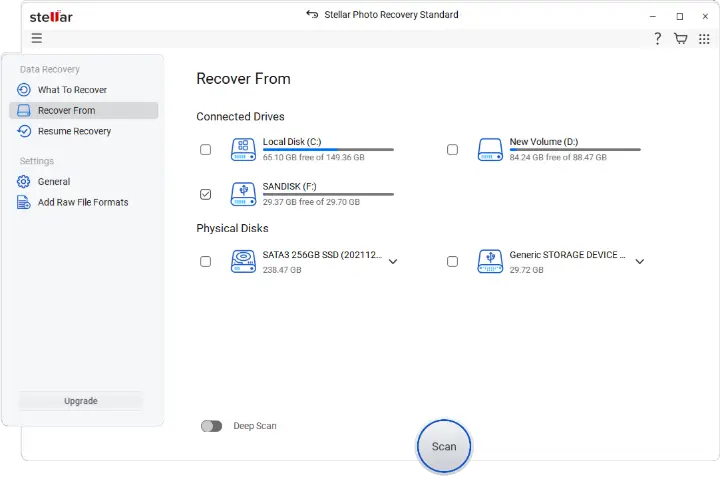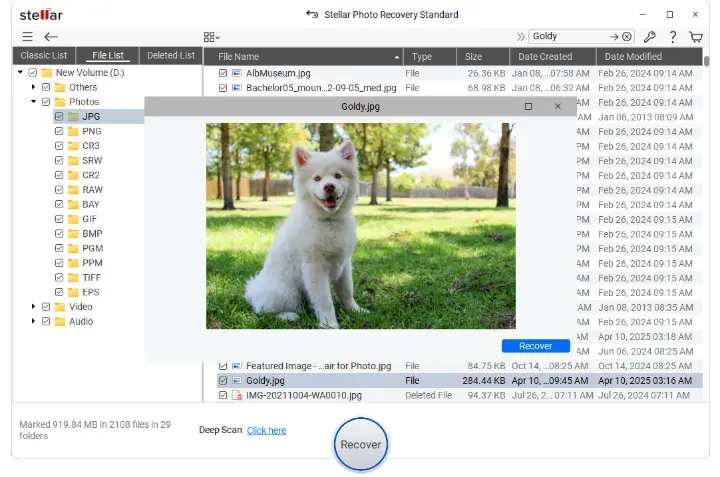Formatting an SD card – either intentionally or by following a misleading prompt – can put you in trouble, especially if something important is stored in it. You might have saved your precious photos, videos, work files, or other important data on your SD card. Formatting it without proper backup led to the immediate deletion of all its content. The good news? Fortunately, several professional data recovery methods as well as third-party recovery tools are available that you can try to restore your lost files.
In this article, we’ll walk you through exactly how SD cards are formatted, what to do after accidentally formatting your SD card, and how you can try the available recovery workarounds to recover lost files.
What Formatting Really Does (Quick vs Full)
Formatting isn’t just wiping all data from your storage device. Before jumping to recovery workarounds to restore your lost files, try to understand what formatting does. There are two types of formatting:
Quick Formatting
This is the finest and fastest formatting mode. When you quick-format your storage device, including an SD card, it deletes the file system entries (i.e., the index that tells the system where files are stored), but the actual data remains intact on the card until it's overwritten.
Full Formatting
This method erases the file system and scans the card for bad sectors. Depending on the method used, it might overwrite the data, making recovery more difficult—though not always impossible.
Step-By-Step: What To Do After Formatting
When you find your SD card is formatted, it is important to consider certain tips which make your SD card recovery quite easy and simple. For this:
Step 1: Stop Using the Card
The moment you find any file missing from your SD card or the card has been formatted, stop using it immediately. Avoid saving new photos, recording videos, or copying anything to the card. Saving new files or transferring data can overwrite the deleted files and make the recovery quite complex.
Just remove the SD card and set it aside for recovery.
Step 2: Assess the Situation
Now that your SD card is formatted and all its content is deleted, determine which type of formatting it was.
Quick: This formatting is done via a camera, phone, or Windows/macOS when the "Quick Format" option is selected. In this case, recovery is easy and quick.
Full: This is mainly done with special formatting software or by unchecking "Quick Format" during setup. This makes recovery more difficult, but not impossible.
Step 3: Prepare for Recovery
No matter how your SD card was formatted, it’s crucial to start the recovery process right away. To do this, you will need:
● A computer (Windows or Mac)
● An SD card reader (if your computer doesn’t have a built-in slot)
● Previously created backups or a reliable data recovery software
Quick Methods to Recover Files From a Formatted SD Card
Accidentally formatting your SD card doesn’t always mean your files are gone forever. Here are some quick and effective ways to get them back, starting with the easiest.
Method 01: Use the Professional Data Recovery Software
If your SD card isn’t physically damaged, third-party software such as Stellar Photo Recovery is one of the best choices for photo recovery and an user-friendly option to restore photos. It is an all-in-one recovery software which allows you to restore deleted multimedia files of various types, including photos, videos, and audio files. The software supports recovery of files deleted due to accidental deletion, formatting, human error, or any other reason.
Here’s how to recover files from an accidentally formatted SD card using Stellar Photo Recovery:
● Download and install the Stellar Photo Recovery software on your Windows PC or Mac (avoid downloading the software on the same SD card you want to recover files from).
● Connect the SD card to your computer using an SD card reader.
● Launch the software and from the homepage, select the type of file you want to recover or choose All Data to recover everything. Click Next to continue.

● From the Recover From window, choose the SD Card Drive from where you need to recover lost files and click Scan to initiate the scanning process.

● Once the scan completes, preview the recoverable files and click Recover to save them to a different location (never to the same SD card).

Method 02: Recover Deleted Files Using Backups
If you are good at maintaining regular backups of your important files, recovery becomes quick and hassle-free. You can try following backup options to restore your deleted files after accidentally formatting your SD card:
● Cloud Storage: Cloud backup services like Google Drive, iCloud, Dropbox, or OneDrive often store photos and videos automatically.
● Camera Backup Features: Many cameras have wireless transfer options that sync files to a computer or mobile app.
● Local Backups: If you regularly transfer SD card data to your PC, check your local folders to find deleted files.
Method 03: Use Professional Data Recovery Services
If your SD card is physically damaged or the above methods fail to restore your files after accidentally formatting your SD card, then a professional recovery service is the best option. Among several such recovery services, the Stellar Data Recovery Services is known best for handling severe corruption, hardware damage, and complex data loss scenarios. Their professional experts use specialised tools unavailable to the public for data recovery.
Preventing Accidental Formatting in The Future
Now that you are familiar with quick recovery workarounds to restore files accidentally deleted from formatting SD cards, it’s time to check some additional preventive tips. You can consider the following tips to avoid future formatting disasters:
● Label Your SD Cards: Labelling or marking your SD cards can help you identify them easily and avoid accidental formatting.
● Double-Check Before Formatting: It is important to check and ensure that you are formatting the right device.
● Keep Regular Backups: Create regular backups of your important files using cloud services or external drives to keep copies of your data.
● Use Write-Protect Switch: Some SD cards have a small lock switch that prevents any writing or formatting.
● Avoid Unnecessary Formatting: Only format the card when required, such as after transferring all files and ensuring backups are made.
Wrapping Up
Accidentally formatting your SD card may put you in trouble, but it doesn’t have to mean permanent loss. It is important to act quickly as the sooner you act, the easier it will be for you to recover photos and other media files from formatted SD cards. If you have any backups of lost files, then try these backups to restore them. Otherwise, move to third-party professional data recovery software like Stellar Photo Recovery or recovery services to get your deleted files back. With the right approach, your accidentally formatted SD card can be restored — and your precious memories or important files recovered.